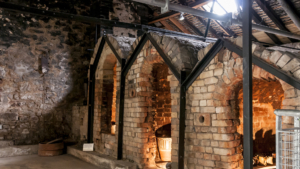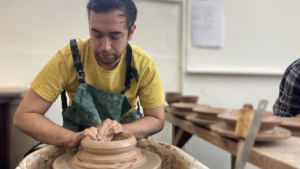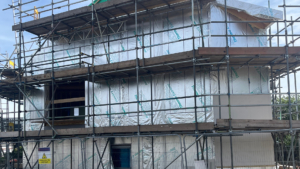- Posted on June 2nd, 2025
The Leach Pottery – Firing Up Change: Exploring a Path to Carbon Neutrality

For Arts Council England and Julie’s Bicycle’s annual report 2023-24, we feature over 50 practical examples of cultural organisations taking climate action including in depth case studies like this one. Check out the full interactive report here.
This case study was written by The Leach Pottery – a museum, learning centre and pottery studio based in St. Ives, Cornwall. They outline their Life Cycle Assessment (LCA) of studio pottery production to identify major carbon impact areas, focusing on gas firing, heating, lighting, and packaging materials, to inform their ambitious journey towards carbon neutrality by 2030 through new building designs and alternative firing methods.
Introduction
At The Leach Pottery we fire pots using electric kilns for bisque firing and gas kilns for glazing, based on an evolution of firing techniques onsite going back over 100 years. Previous fuels for firings onsite included wood, paraffin, oil, electric and gas.
Although our current work is based on a living tradition and creativity through flame, we are committed to reducing our carbon footprint with the aim of being carbon neutral by 2030. This means that it is important to review what we currently do and understand the current impact before deciding how to move forward.
A Life Cycle Assessment (LCA) was commissioned from the University of Exeter, carried out by chemical engineer Professor Xiaoyu Yan and Dr Giorgio Salani who is researching sustainability of ceramics in Tokyo.
“We are trying to evaluate the associated environmental impact to get a holistic view. One of the key tools we use in our research is LCA – life cycle assessment. The concept of the carbon footprint is based on LCA. The principle is the same whether looking at an individual product, person, company or even a country. You measure the impact, in this case, we looked at the raw material extraction all the way to the end of the life of that product. This considers the different resources, its production and the waste that comes out of the product during its life cycle.”
– Professor Xiaoyu Yan
We wanted to be able to look at alternative ways of firing (as well as the whole process of making from raw materials through to postage) to see how much carbon we could eradicate from the process. It was important to measure the current process as a clear benchmark to make improvements against and enable us to understand where the biggest impacts were in the process.
This is the first LCA of a UK studio pottery and we hope the results will also be useful to others in the studio pottery community as a benchmark.
“This study is important for UK studio pottery at large as this is a leading study in this sector that provides useful insights for many British and international makers using similar equipment (e.g. gas kilns, packaging material, inefficient lighting, etc.)”
– Dr Giorgio Salani

The Results
The results show what you would expect – that the gas firing creates the highest carbon footprint – 36.5%, however less expected was the large impact our heating (11%) and lighting systems (11%) were for the studio space. Bisque firing using the electric kiln (10.3%) is also a significant contributor. The most surprising of all was that packaging materials totalled 18.6% which included interleaf white paper (8%) and cornstarch peanuts (6%) which have high embedded carbon emissions.
The packaging is used to send the pots off to their new homes and although we removed plastic from our packaging several years ago we didn’t realise that our ‘environmentally friendly’ packaging has such a high carbon footprint.
The smallest contributions were from raw materials for the mug (6%), manufacturing of machinery (1%) and manufacturing of tools (<1%).
One result we were keen to understand is the total carbon footprint of a mug compared to other things. As a comparison, 1kg of pottery we make has 17% of the carbon footprint created by the same weight of red meat.

Actions
Using this baseline, we are able to target all these results one by one. Firstly, we are radically changing our site – building a new carbon neutral building (including PV) to house the new studio – -which will radically reduce the 22% of the carbon footprint they currently use on heating and lighting as well as removing natural gas from this system.
We have now built some new trial kilns (these are already more efficient and better insulated than the originals) with the aim of trialling bio-fuels including bio-methane and hydrogenated vegetable oil to get away from natural gas. They have two connected chambers as we are testing the old technology of the historical Japanese climbing climbs used onsite until the 1970’s. These old kilns reuse the heat from one chamber into another, which is not usually done with gas/oil kilns. The aim is to build a permanent 3-chamber kiln using this system using much less fuel; due to efficiencies, recycling of heat, and fuel from a renewable source.
As well as researching alternatives to natural gas we hosted a residency by Jordan Ward-Williams from the University of Cambridge who looked at alternatives to creating our current glazing style through electric glazes. These results will be shared at the Making Futures conference in October in Plymouth and with the wider pottery community through a ClayCraft article. For many people who have electric kilns (and no gas kiln) this is an exciting possibility of being able to access these traditional glazes for the first time.
As an organisation, we recognise the climate emergency and the importance of taking steps to reduce the impact we have on our climate. We are fortunate to receive grant funding to develop our site and hope to share our experiences to help others in the studio pottery community.
You can see our most recent conference around sustainability including a presentation of the results online.

Header image: Leach Pottery studio, museum and education centre in St Ives, Cornwall. Credit: Jonny Weeks
